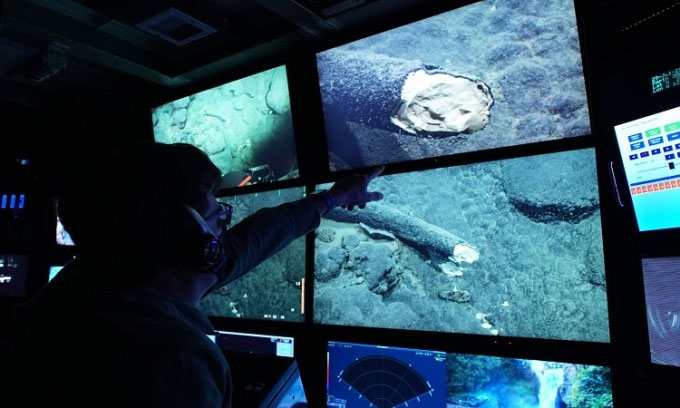Researchers have discovered a tusk from a stranded woolly mammoth carcass that fell to depths of over 3,000 meters beneath the Pacific Ocean.
A young female woolly mammoth once roamed near what is now the Central Coast region of California, USA, and died there. Although the mammoth died on land, its massive body eventually ended up beneath the Pacific Ocean. Carried by ocean currents, its carcass drifted over 241 kilometers from the coast to a depth of 3,048 meters, next to an underwater mountain. The mammoth’s remains lay there for millennia, unnoticed by anyone.

Scientist Steven Haddock points to the tusk on the screen of the Western Flyer. (Photo: Darrin Schultz/MBARI)
However, everything changed in 2019 when scientists from the Monterey Bay Aquarium Research Institute accidentally found the tusks while using remotely operated vehicles to explore new deep-sea species off the coast of Monterey (MBARI), California. The research team sought to collect the mysterious specimens. Unfortunately, the tip of the specimen, shaped like a sabre, was broken. They took a small piece and left the rest in its original position. It wasn’t until they examined the fragment that the researchers confirmed they had encountered a tusk, but it was unclear which species it belonged to or from which era.
Finding such a specimen in the deep sea is highly unusual. Tusks and bones of prehistoric creatures are typically buried deep underground or encased in permafrost near the Arctic Circle. While some specimens are found in shallow waters in the North Sea of Western Europe, researchers have never found traces of woolly mammoths or any ancient mammals in such deep waters.
Steven H.D. Haddock, a marine biologist at the institute, usually focuses on bioluminescence and the ecology of jellyfish in the deep sea. However, he was captivated by this unique scientific specimen. Therefore, Haddock gathered a team of scientists from the institute, the University of California, Santa Cruz, and the University of Michigan to explore the mystery. Their preliminary research indicated that this was not only a woolly mammoth carcass but also a mammoth that died at the end of the Paleolithic era, a period that lasted from 2.7 million to 200,000 years ago.
Further research on the specimen could help answer long-standing questions about the evolution of woolly mammoths in North America. The discovery also suggests that the seabed may be rich with paleontological specimens, enhancing our understanding of the past. But before the research team could delve deeper into the specimen, they needed to return to the sea to collect the remaining part of the tusk.
On July 27, Haddock boarded the Western Flyer, the largest research vessel of MBARI, along with several colleagues. Accompanying him were Daniel Fisher, a paleontologist from the University of Michigan, and Katherine Louise Moon, a postdoctoral researcher at the University of California, Santa Cruz, who specializes in ancient DNA.
Before the trip, Moon collected enough DNA from the broken tip to determine that the tusk came from a female woolly mammoth. Her conclusion was supported by Fisher, who noted that the shape and size of the tusk were characteristic of female woolly mammoths. Terrence Blackburn, another researcher at the University of California, Santa Cruz, could not join the trip, but his preliminary analysis provided estimates of the mammoth’s age at death.
Onboard, the research team took just two days to reach the underwater mountain where the tusk was located. On the morning of July 29, the ship arrived at its destination. Haddock and his colleagues immediately began their search. They focused in the ship’s control room. Through the screens, the team excitedly watched as the remotely operated vehicle named Doc Ricketts was gradually lowered into the water. When the vehicle reached its target, the control room was filled with scientists, engineers, and crew members, all eagerly monitoring the recovery process of the tusk.
Almost everything on the underwater slope below the vehicle was covered by a layer of black iron-manganese. This made the search for the tusk challenging. However, after less than 15 minutes of searching, the tusk unexpectedly appeared on one of the screens. Haddock and his team were concerned that the tusk might break when lifted, so they took their time to photograph and video-record the tusk to create a 3D model in case the specimen broke during the recovery.
Soft plastic fingers were attached to the arms of the vehicle to facilitate lifting the tusk. Subsequently, the unmanned vehicle placed the specimen into a containment box. The search and recovery of the tusk took less than two hours. Shortly after, the remotely operated vehicle returned to the surface. Haddock and Fisher quickly retrieved the tusk for measurement, cleaning, and photography. They hoped that the specimen contained more woolly mammoth DNA than the broken tip, enough to identify which species the mammoth belonged to under the water grave.

















































